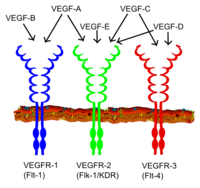
Photo from wikipedia
Receptor-interacting protein kinase 1 (RIPK1) contributes to a broad set of inflammations and necroptosis in human diseases, which also plays an important role in the pathogenesis of Alzheimer's disease (AD).… Click to show full abstract
Receptor-interacting protein kinase 1 (RIPK1) contributes to a broad set of inflammations and necroptosis in human diseases, which also plays an important role in the pathogenesis of Alzheimer's disease (AD). The inhibition of RIPK1 could be a novel strategy to improve cognitive function. SZM679, a highly specific RIPK1 inhibitor (Kd,RIPK1 = 8.6 nM, Kd,RIPK3 > 5000 nM), was developed by our group with superior high antinecroptotic activity (EC50 = 2 nM), and investigated to completely reverse the tumor necrosis factor-induced systemic inflammatory response syndrome. In a streptozocin-induced AD-like mouse model, behavioral tests showed that SZM679 apparently ameliorated learning and memory dysfunction. Nissl staining revealed that SZM679 improved neuronal loss. Moreover, the Tau hyperphosphorylation, neuroinflammation, and the RIPK1 phosphorylation level in the hippocampus and cortex were significantly decreased in the SZM679-treated group. Collectively, SZM679 represents a promising lead structure for the discovery of novel RIPK1 inhibitory anti-AD agents.
Journal Title: Journal of medicinal chemistry
Year Published: 2022
Link to full text (if available)
Share on Social Media: Sign Up to like & get
recommendations!